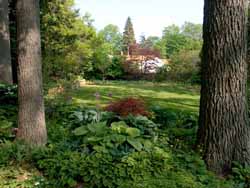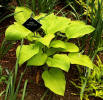 Often
when I ask people if they get full sunlight on their plants,
they respond, "Most of the time." Full sun literally means
from sun up to sun down each day. Full sun plants
will generally "get by" with 6 or more hours of direct
sunlight but this means that the remainder of the day is spent
in some state of shade.
Often
when I ask people if they get full sunlight on their plants,
they respond, "Most of the time." Full sun literally means
from sun up to sun down each day. Full sun plants
will generally "get by" with 6 or more hours of direct
sunlight but this means that the remainder of the day is spent
in some state of shade.
So, any site in our landscapes that receive less
than 6 hours of continuous, uninterrupted sunlight per day falls
into the realm of shade. There is often confusion about the
term "shade" applied to our gardens. It is often used as if it were
a single condition but as gardeners, we all know that there are
variations of shade too.
For convenience, I tend to divide shade into three categories based
on the amount of light that reaches the plants beneath each day.
-
Light Shade - Also called
dappled shade or partial shade,
this shade is produced by trees with a thin canopy of small
leaves. A clump of small birch, honey locust or dogwood trees
would cast a dappled shade. It might be an area that gets
5 hours of sunlight split into two hours in the morning, two in
the afternoon and one in the evening. Many plants will thrive in
this amount of sunlight including some of the "sun-loving"
types.
-
Moderate Shade - This is
also known as medium shade or high shade and could be provided
by large, old oak trees for example. The first branches may be thirty feet off the ground and plenty
of light makes its way through. However, a direct shaft of
intense sunlight rarely shines on a particular space for more
than an hour or so during the course of the day. Many people
feel that this may be the best type for most shady gardens. You could sit under this
shade and read a book without any problem but the actual sun
rays would only directly hit the book pages for short periods
during the day. It is bright but little, if any intensive
sunlight hits the plants.
-
Dense Shade - This is the
deep, dark shade we find close to the north side of a building
or under spruce or pine trees or Norway maples. As the sun goes
across the horizon during the day, these areas receive no direct
sunlight. The only light is that which is reflected from the surroundings.
Immediately next to the north side of a building which has an
overhang or under densely foliated trees such as Norway maples
or spruce trees would qualify for this category.
Remember that all plants need a certain
minimum amount of light intensity for them to complete
photosynthesis. Some plants can carry on this process in
extremely low light but most require at least what we call
"bright indirect" light to function properly.
Hosta and impatiens are two species of plants commonly
grown in the shade. Both are
 often
called "shade loving" when, in fact, they are shade tolerant.
Both will survive in dense shade but may not thrive and grow
their best in those conditions. Planted under a spruce, both
plants will generally grow very slowly. Given a bit more
light, they will thrive. Both can be grown in the full sun but
they will suffer unless soil and watering conditions are
perfect. So, for most of us, they do best when grown in
dappled to open shade.
often
called "shade loving" when, in fact, they are shade tolerant.
Both will survive in dense shade but may not thrive and grow
their best in those conditions. Planted under a spruce, both
plants will generally grow very slowly. Given a bit more
light, they will thrive. Both can be grown in the full sun but
they will suffer unless soil and watering conditions are
perfect. So, for most of us, they do best when grown in
dappled to open shade.
Light and Moderate shade are ideal
places in which to grow
hostas and their associated companion
plants. Under these conditions (given a water retentive soil
enriched with compost), hostas will multiply as fast as the
particular cultivar can and will flower at their best.
Dense shade is the most difficult
environment for growing plants including hostas. Shade tolerant
"woodland-type" plants will survive here but will probably not
thrive. They may expand very, very slowly compared to the other
shade types. Flowering may be poor or non-existent for some
cultivars.



